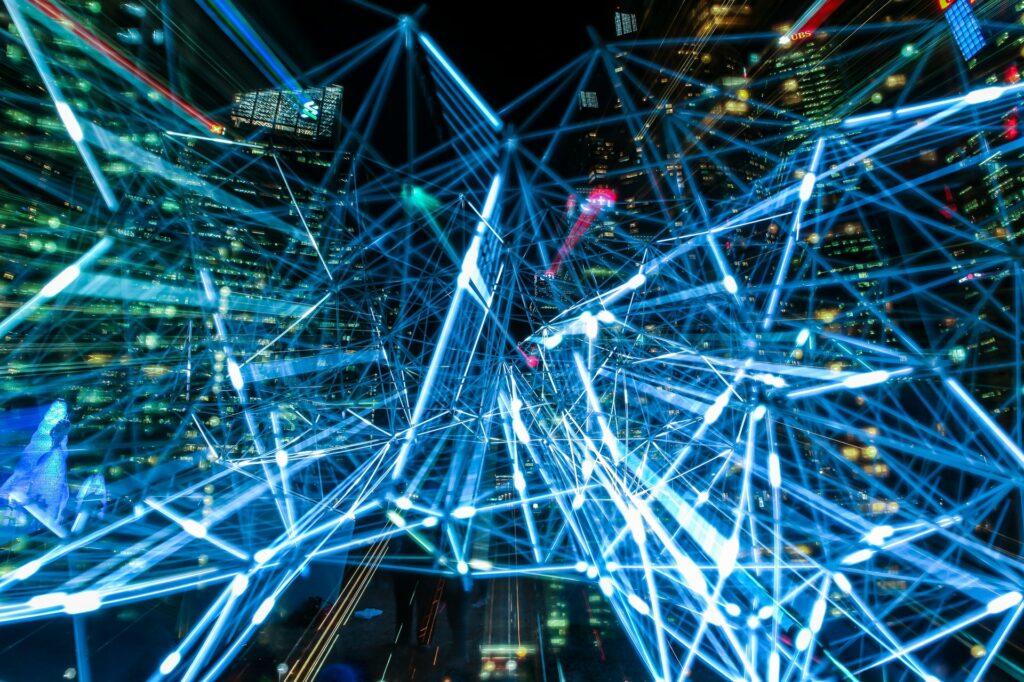This Is the Difference Between Artificial Intelligence and Machine Learning

By Igor Bobriakov, Hotelmize
1. Are Machine Learning and Artificial Intelligence the same thing?
The Fourth Industrial Revolution, or the new era of technology, is driving rapid advancements in the development of Artificial Intelligence and machine learning as a prominent part of its set of technological developments.
Klaus Schwab, the founder and chief executive of the World Economic Forum, described the Fourth Industrial Revolution (4IR or Industry 4.0) as a “technical revolution that will fundamentally alter the way we work, live, and relate to one another.”
These technologies are capable of merging the physical, biological, and digital worlds, creating cyber-physical systems, representing “entirely new ways in which technology becomes embedded within societies and even our human bodies… including genome editing [and] new forms of machine intelligence.”
In many aspects, Artificial Intelligence is already pervasive throughout our society. It is found in self-driving cars, robotics, drones, virtual assistants, data science, data analytics and data security, predictive financial trading systems, and recommender systems found on websites such as Amazon and Netflix. However, this term is often misunderstood and used interchangeably with the term “machine learning.”
In summary, while both AI and machine learning are similar, they are not the same. In fact, machine learning is a subcategory of AI. Therefore, let’s look at an in-depth definition of both the Artificial Intelligence and machine learning paradigms.
2. Artificial Intelligence versus Machine Learning
The tech industry worldwide is currently talking about the increased adoption of Artificial Intelligence, machine learning (ML), and deep learning (DL). All these acronyms are used interchangeably in the tech genre. However, it is essential to understand where each of these constructs fits within the AI paradigm.
As highlighted above, machine learning (ML) and deep learning (DL) form part of the overall Artificial Intelligence (AI) archetype. Therefore, they are similar yet dissimilar. Let’s expand on this discussion by describing what AI and ML (and DL) are, their similarities and differences, and what use cases for each are.

2.1. What is AI, but not Machine Learning?
Wikipedia.com defines AI as “intelligence demonstrated by machines, unlike natural intelligence displayed by humans and animals, which involve consciousness and emotionality.”
Google AI researcher François Chollet expands on this definition in his book, “Deep Learning with Python.” He states that AI is an “effort to automate intellectual tasks normally performed by humans. As such, AI is a general field that encompasses machine learning and deep learning, but also includes many more approaches that don’t involve any learning.”
In simple terms, the phrase “Artificial Intelligence” can be divided up into two separate words:
- Artificial: Non-human or unnatural element such as a computer made by human beings.
- Intelligence: The ability to think or understand.
Therefore, AI is the ability of a non-human machine or computer to think and display a form of understanding through technologies like machine learning, deep learning, and neural networks. It allows machines like robots and computers to think without human intervention.
AI is also divided up into three types.
- Artificial Narrow Intelligence (ANI): Goal-oriented and programmed to perform a single task.
- Artificial General Intelligence (AGI): This form of AI allows machines to learn, understand, and act similar to the human brain in a given scenario. The proper implementation of AGI performs these tasks in a manner that is almost indistinguishable from the human brain.
- Artificial Super Intelligence (ASI): This is a hypothetical construct where machines can display intelligence that is superior to the human brain.
2.2. What is Machine Learning, but not AI?
As noted, multiple times, machine learning is a subset of AI.
Wikipedia.com describes machine learning as the “study of computer algorithms that improve automatically through experience.” These machine learning algorithms build models based on sample data used to train the model to behave in a specific manner.
There are many different types of machine learning algorithms, including the following models.
- Supervised learning: A mathematical model of a dataset containing both inputs and required outputs is used to train the model to reach the desired outcomes. This input and output data is known as training data and includes multiple inputs and the preferred output. Using the inputs as training examples, this model teaches itself or “learns” to reach the desired outcome.
- Unsupervised learning: The fundamental difference between supervised and unsupervised learning is that the unsupervised model utilizes training data containing the inputs without any outputs. This model identifies commonalities in the data and provides one or more results based on the absence or presence of these patterns.
- Semi-supervised learning: This machine-learning algorithm falls between supervised learning and unsupervised learning. In other words, the training data provided includes multiple inputs and not all of the required outcomes. While, at first glance, it may seem that this model might not add value to the machine learning construct, it does. Researchers have determined that modeling training data with a percentage of the total inputs and outputs required to train a supervised learning model can improve learning accuracy.
Typical use cases for machine learning include scenarios where it is not feasible nor possible to develop conventional algorithms to solve the challenge and “do the job” as it were. Examples include email filtering, and fingerprint, face, or iris verification.
Several other use cases or examples where machine learning is used include the following.
- Computational statistical models that focus on making computerized predictions, such as the predictive financial market trading model highlighted above, are an important use case in the machine learning paradigm.
- Mathematical optimization or programming models deliver the theory and practice of selecting the correct element in a series of proffered alternatives. These models provide solutions to different qualitative disciplines, including computer science, engineering, economics, and operations research.
- Data mining models, developed by data scientists, focus on exploratory data analysis via unsupervised learning.
2.3. What is deep learning?
While the deep learning paradigm is not part of this article’s core focus, it is worth taking a brief look at it. In summary, as with machine learning, deep learning is a subset of Artificial Intelligence. And its model is inspired by the way the human brain filters information.
As an aside, artificial neural networks are similar to deep learning models. Neural networks mimic the structure of the human brain. Ergo, the brain comprises connected networks of neurons. Additionally, different parts of the brain are responsible for processing different pieces of information, so these parts are arranged in layers or a hierarchy.
So too is the artificial neural network designed. They seek to simulate the brain’s structure as they attempt to get computers to behave like interconnected brain cells.
3. Use case scenarios for Machine Learning and Artificial Intelligence
As stated directly, and inferred throughout this discussion, the practical applications of the Artificial Intelligence and machine learning paradigms are increasing exponentially.
Therefore, let’s answer the following questions by considering a use case for ML and AL, respectively.

3.1. What situations are relevant to apply AI, and what kind of problems can be solved with it?
Examples of situations where AI was used and what problems it solved
There are multiple scenarios or use cases for Artificial Intelligence where all sorts of problems or challenges are solved. Therefore, let’s consider the use case for the use of AI by the well-known and visible company, Tesla, in the way that it uses AI to drive the development of AVs (Autonomous Vehicles).
In the article published on his website, Bernard Marr describes how Tesla has become a market leader and pioneer in the electric vehicle market. What is perhaps not as well known is that Tesla is also a tech pioneer with a considerable interest in developing autonomous vehicles. Consequently, they are acutely interested in Artificial Intelligence.
As an aside, Elon Musk, the founder of Tesla, noted towards the end of 2017 that the company was busy building its own AI hardware. Musk is also a co-founder of OpenAI, a research organization aimed at ensuring that AI is “developed and deployed in a safe, manageable way so as to minimize and existent risks robots may one day pose to humanity.”
As a result, all of the vehicles Tesla has ever built have the capability to become self-driving in the future. And all vehicles send volumes of telemetric and other data to the cloud, where it is transformed into meaningful information using AI and machine learning models, allowing Tesla to troubleshoot vehicle errors and refine future vehicle iterations.
This data is not only valuable to Tesla but is valuable in its own right. McKinsey and Co-researchers estimate that the market for vehicle-gathered data will be worth $750 billion a year by 2030.
Details of the AI technology used by Tesla are sparse because it has commercial value. However, it is known that earlier iterations of the AI models used by Tesla are primarily built on an unsupervised learning paradigm.
A second use case for AI is an intelligent chatbot used to provide online customer service. There has already been and continues to be widespread adoption of this tool on travel agencies, tour operators, travel tech websites, social media platforms, and instant messaging apps.
AI chatbots can answer questions and provide valuable information to customers, especially out of office hours or when customer service center agents are not available. The reality is that customers are demanding faster response times on multiple online platforms. And Artificial Intelligence, in a number of applications, allows businesses to provide the next level of customer service 24/7.
3.2. What situations are relevant to apply Machine Learning, and what kind of problems can be solved with it?
Examples of situations where machine learning was used and what problems it solved
As with AI, there are multiple use cases for implementing machine learning to solve challenges across a wide variety of scenarios. Therefore, let’s look at how Google uses machine learning to remain a fully sustainable, eco-friendly business.
Once again, we turn to Bernard Marr for a use case study of how machine learning is successfully used by the world’s biggest search engine provider, Google.
Not only was Google’s aim to become the world’s most prominent organizer of the ever-increasing information found on the World Wide Web, making it universally accessible and valuable, but it has also reached this aim in a way that does not deplete the globe’s natural resources.
The company was entirely carbon neutral by 2008 and set the lofty goal of only purchasing 100% renewable energy for their operations by 2018. Statistics show that their data centers account for 2% of the world’s energy usage; thus, creating efficiencies across its network of 14 data hubs has been a priority. The biggest challenge was that the intensely complex nature of equipment included infinite server and network configurations, chillers, cooling towers, control systems, and heat exchangers.
As pioneers of machine learning and deep learning, Google utilized these technologies to help them achieve the goal of using 100% renewable energy by 2018. They also managed to reduce their overall energy usage in these data centers by 40% by training machine learning algorithms to see patterns in the different data centers’ energy usage metrics.
In essence, Google fed the complex machine learning algorithms with massive amounts of energy usage data, training the models to detect high energy usage patterns, providing Google engineers with information to optimize and reduce energy usage.
Simultaneously, Google has managed to maximize its landfill diversion rate in its global data centers. 86% of all the waste generated by these data centers is reused or recycled. Only 14% of all waste ends up in landfill sites around the world.
A second use case for machine learning, specifically in the travel and tourism industry, is the use of a recommender system across all online platforms, including websites, social media, and messaging apps.
George Seiff of KDnuggets.com describes recommender systems as “an important class of machine learning algorithms that offer “relevant” suggestions to users. Categorized as either collaborative filtering or a content-based system, check out how these approaches work along with implementations to follow from example code.”
In other words, a recommender system website uses the information the user provides to recommend additional options to choose from. For instance, when browsing a travel agency website, the user clicks on different types tours through of England, Scotland, and Wales; the recommender system will use this information and provide alternative tour options through the same region as well as tour options through other areas close to of England, Scotland, and Wales, such as Northern Ireland.
One more example is how over the last five years, machine learning has been responsible for the increase in digital travel sales numbers as a consequence of the advancements in the use of machine learning models to analyze Big Data. The experts at datumize.com report that over $500 billion (USD) was generated in 2016 alone.
Another example is to use machine learning hotel price forecasting tools to get the best deals on hotel prices. Not only do these tools report on forecast trends, but many also have an automatic monitoring function that automatically tracks hotel room price movements.
4. Can I learn AI without Machine Learning?
By its very nature, Artificial Intelligence can exist without machine learning and deep learning, but these two constructs cannot exist without AI. Therefore, for anyone wanting to dive into the science and practice of Artificial Intelligence, it is not necessary to add machine learning to the mix.
5. Final thoughts
Lastly, Artificial Intelligence, and by extension, machine learning and deep learning, is pointing the way to the future. The integral nature of AI within the fiber of the world as we know it is fundamentally driven by the Fourth Industrial Revolution. As time passes, both anecdotal and scientific evidence demonstrates that, as posited by Klaus Schwab, within 4IR, these technologies are indeed merging the physical, biological, and digital worlds, leading to an innovative, exciting future.






Responses